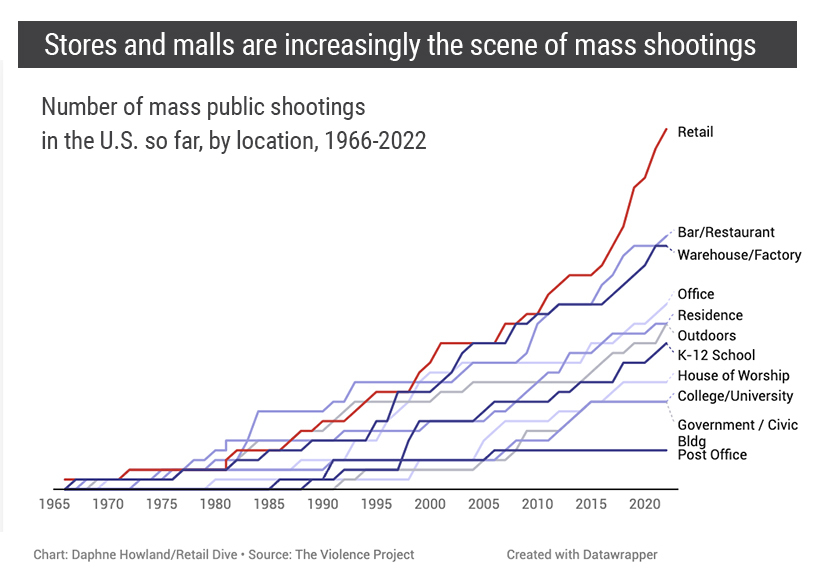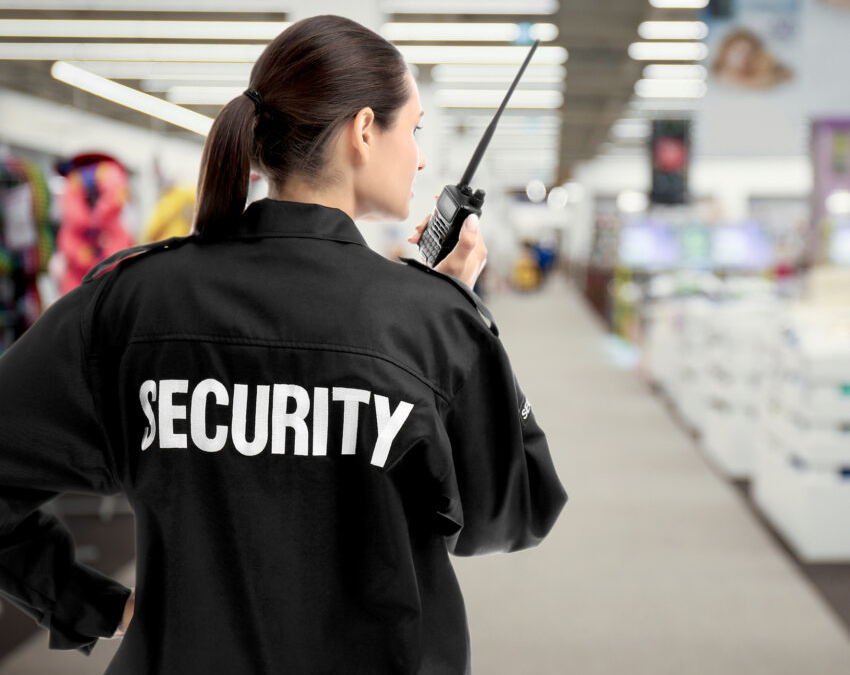It’s gotten to the point that reports about mass shootings are almost a weekly occurrence on the nightly newscasts. Seemingly, no public or even semi-public venue is off-limits nowadays when it comes to this uniquely American form of mass violence. In fact, according to a recent Axios-Ipsos poll, gun violence is now Americans’ top public health concern, bigger than the opioid epidemic and cancer.
And it’s easy to see why.
Over the past couple of years, episodes of mass shootings resulting in four or more victims murdered by firearms, not including the shooter (the standard technical definition of a mass shooting as per the U.S. Congress) have erupted at churches, synagogues, schools, sports bars, nightclubs, grocery stores, and shopping malls to name just a few of the categories of public venues that have been targeted by mass murderers. In a recent four-day stretch alone from May 10 through May 14, 15 episodes of gun violence were recorded around the country in states from California to New Jersey, Louisiana to Indiana, and just about everywhere in between.
Retail at Risk
In the US, according to the Violence Project which keeps track of gun violence and mass murders, retail venues have been subject to a mass public shooting every decade over the past 60 years, although more than half of those incidents recorded have occurred in the last 15 years. Data from the Violence Project database show just how much more susceptible the retail industry has been to mass shootings than bars and restaurants, office complexes, schools, places of worship or government installations.

When it comes to retail locations, be they mom & pop stores, corner bodegas, department stores, shopping malls, or big box retail locations, the challenge for store operators has been balancing adequate security and a safe shopping experience with ease of access, the critical component in driving traffic and moving inventory. For large-footprint stores and malls where the entire idea is bringing lots of people together, the challenges are particularly vexing.
This tradeoff among competing interests – often dubbed in retail circles as the “Sales versus Security” conundrum – has presented a daunting set of challenges for industry executives. While malls and retail outlets were once synonymous with relaxed shopping and pleasurable visits, they are increasingly becoming known as America’s new killing fields, prime targets for those seeking to wage acts of violence with maximum impact.
On the Offense
What can be done to prevent or deter mass shooters from choosing retail locations as a place to unleash their violence? How can retail executives best position their physical stores so that customers feel free to enjoy the retail experience while not feeling unduly encumbered by layers and layers of security protocols, much like those found at airports and Federal buildings? The answers aren’t easy, and they often involve making conscientious tradeoffs between equally hard and distasteful alternatives.
While many brands are experimenting with a host of innovative solutions and implementing forward-thinking workarounds, others continue to struggle with this new reality that is sweeping across the retail landscape. No one has yet cracked the code as they all seek to find that ideal and delicate middle ground that balances store security with brand reputation, shopper experience, ease of access, and maximizing sales potential.
Retail industry groups have been leaning into this issue in a big way, attempting to pull their members along – many of whom recognize the emerging threat but bristle at the extra costs associated with hardening their stores. In its annual “Retail Security Survey” issued late last year, the National Retail Federation (NRF) found that “mass violence/active assailants” is a growing concern of nearly two-thirds of its members. The Retail Industry Leaders Association (RILA) has been active in promoting education around the issue and has actively encouraged its members to conduct regular active-shooter training exercises for staff. But while industry associations have been vocal about this issue, it’s at the management level of individual retail brands where the rubber meets the figurative road.
Secure and Safe
The Robin Report spoke off-the-record with several security officials experienced in securing large-footprint retail locations. These conversations were with security consultants that have worked with large venues including big box stores, as well as actual store managers, and all shared what types of new tactics and techniques are being deployed or experimented with as they all continue to grapple with America’s epidemic with mass shootings and its impact on retail.
Here is what they say is happening behind the scenes.
- Enhanced Presence of Visible Armed Security Personnel
Most stores have moved to augment their physical security presence. And while the presence of additional armed security personnel can provide a modicum of reassurance to shoppers, most analysts agree that there is a limit and it is important that stores strike a balance that avoids creating an atmosphere akin to a high-security facility. Nonetheless, many stores feel that having a larger and more visibly armed security presence is a reasonable tradeoff that communicates to shoppers that any potential violence can be shut down rapidly.
- AI-Assisted Detection and Predictive Intervention Tech
Additional security measures, such as advanced surveillance systems and access controls, are being discreetly integrated into retail spaces. AI-driven technologies are being installed to constantly scan store perimeters and alert security personnel ahead of time of any individuals approaching retail locations with visible weapons or satchels that could be potentially hiding longer guns. It’s an approach that is gaining traction as it allows for effective monitoring and response without overly intruding on the shopping experience.
Other retailers have adopted or are in the early stages of experimenting with cutting-edge technologies to enhance security by using facial recognition that matches databases of known criminals with security protocols, alerting security personnel to their presence in real time. The limitation of these technologies, is of course, that many mass shooters are first-time offenders and unknown to the criminal justice system. And this is to say nothing of the myriad and likely thorny privacy issues that will become more acute as these technologies gain traction.
- Beefed Up Store Communications
Many stores are posting more signage alerting would-be mass shooters that might be staking out a location ahead of time. The presence of more visible and behind-the-scenes monitoring and security can be effective. Traditionally these types of warning placards were meant to discourage would-be shoplifters, but now they have a far more ominous target audience: would-be mass killers.
Transparent communication with shoppers about security measures is recommended by many retail security consultants as a low-friction way to reassure consumers, build trust, and foster a sense of shared community and responsibility. At the heart of these preventive initiatives are a host of new communications strategies aimed at tapping into the public’s sense of shared community and experience, encouraging shoppers to notify store personnel if they spot individuals acting strange or suspiciously. Providing clear information on security protocols and emergency initiatives can also help alleviate concerns while ensuring a safer shopping experience.
- Collaborative Partnerships
To combat the rising tide of gun violence, retailers are also increasingly collaborating with local law enforcement agencies to enhance their security programs and training. Joint programs and information-sharing initiatives are enabling store security teams to engage in a coordinated response to potential threats with local police and sheriff departments. Regular communication channels with law enforcement professionals also facilitate the exchange of best practices and the implementation of up-to-date security protocols.
By fostering stronger ties with local community policing, retailers hope to create a sense of enhanced collective responsibility for safety. Programs that promote dialogue, trust-building, and awareness can help identify potential threats and encourage community members to report suspicious behavior promptly.
- Empowering and Better Preparing Store Employees
Retail executives are also more heavily investing in training for all store employees from career management professionals to seasonal staff, so that they are all better equipped to handle a mass shooting incident. These programs seek to provide comprehensive training on situational awareness and response procedures while also empowering employees to recognize and report suspicious behavior that might contribute to early intervention and prevention. Companies are also establishing clearer communication channels and systems to alert employees in case of emergencies.
- Innovation of Store Layout and Design
In light of the increased potential of mass shootings, many retailers privately concede that they are rethinking store layouts to optimize visibility and minimize blind spots while facilitating ease of egress. Strategic placement of mirrors, transparent barriers, and unobtrusive security infrastructure can improve surveillance coverage while still maintaining an inviting atmosphere. Some store executives have even privately toyed with the idea of installing wall-mounted break-glass “firebox” styled mass shooting kits that would simultaneously sound a general alarm and provide easy access to equipment such as bullet-proof shields, first aid, and other useful items in the event of an active shooter incident.
- Armed Employees
Although it’s quite controversial, some major retail brands are considering testing programs that would train selected store employees to be ready to confront an active shooter. These employees would not only receive firearms training and concealed carry certification but undergo comprehensive training to prepare them to be able to react appropriately and swiftly in the case of an active shooter incident.
Damned If You Do, Damned If You Don’t
Of course, no retail establishment wants to spend too much time publicly talking about its “best-in-class” active shooter prevention infrastructure. Private polling initiated by many retailers in recent years has consistently shown that shoppers are increasingly turned off by the idea that they may encounter an active shooter situation, and no amount of communication about safety information and “what if” scenarios will assuage them from their basic belief that if a store is actually talking about this issue, they feel they are in danger and might as well go elsewhere or shop online.
It’s a real problem for retailers that isn’t going away anytime soon.
Read more on OPERATIONS
About Arick Wierson
Arick Wierson is a nationally renowned political and business columnist for CNN, Observer, CNBC and Vice and a six-time Emmy® Award-winning television producer and documentary filmmaker. Wierson served as a long-time political and media advisor to former New York City Mayor Michael Bloomberg. You can follow him on twitter @ArickWierson
About The Robin Report
The Robin Report provides insights and opinion on major topics in the retail apparel and related consumer product industries. It delivers provocative, unbiased analysis on retail, brands and consumer products, and covers industry-wide issues, trends and consumer behavior throughout the retail-related industries. TRR is delivered exclusively on TheRobinReport.com. Additionally, TRR produces executive briefings and industry events.
If you are not yet a BRA Retail Member, you can easily opt in to either Regular (no cost) or Distinguished ($100/yr.) Membership via this super simple join form

